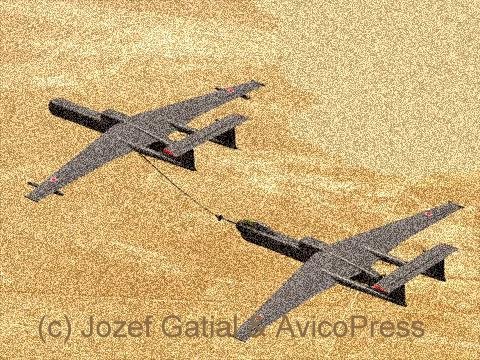- Joined
- 21 April 2009
- Messages
- 13,149
- Reaction score
- 5,995
DARPA Testing Global Hawk Drones As Aerial Tankers
This is some cool footage of DARPA, NASA and Northrop Grumman “wake testing” an MQ-9 Global Hawk drone to test the feasibility of using unmanned jets as an aerial tankers as part of the KQ-X program.
On January 21, the team flew Scaled Composites’ Proteus test jet 40-feet behind the drone at an altitude of 45,000-feet to see how much wake the Global Hawk would leave for any aircraft trying to refuel from it and how well the two planes could maneuver while flying close together at that altitude.
This flight opens the door for an actual aerial refueling operation using two Global Hawks in the spring of 2012, according to Northrop.
“Demonstrating close formation flight of two high altitude aircraft, whether manned or unmanned, is a notable accomplishment,” said Geoffrey Sommer, KQ-X program manager at Northrop Grumman Aerospace Systems sector. “When you add autonomous flight of both aircraft into the mix, as we will do later in the KQ-X program, you gain a capability that has mission applications far beyond just aerial refueling.”
All of this is being done to see if high flying drones can be used to refuel other drones that are flying high-altitude missions that could see them staying airborne for days or longer.
Read more: http://defensetech.org/2011/03/09/darpa-testing-global-hawk-drones-as-aerial-tankers/
With video at the link.
This is some cool footage of DARPA, NASA and Northrop Grumman “wake testing” an MQ-9 Global Hawk drone to test the feasibility of using unmanned jets as an aerial tankers as part of the KQ-X program.
On January 21, the team flew Scaled Composites’ Proteus test jet 40-feet behind the drone at an altitude of 45,000-feet to see how much wake the Global Hawk would leave for any aircraft trying to refuel from it and how well the two planes could maneuver while flying close together at that altitude.
This flight opens the door for an actual aerial refueling operation using two Global Hawks in the spring of 2012, according to Northrop.
“Demonstrating close formation flight of two high altitude aircraft, whether manned or unmanned, is a notable accomplishment,” said Geoffrey Sommer, KQ-X program manager at Northrop Grumman Aerospace Systems sector. “When you add autonomous flight of both aircraft into the mix, as we will do later in the KQ-X program, you gain a capability that has mission applications far beyond just aerial refueling.”
All of this is being done to see if high flying drones can be used to refuel other drones that are flying high-altitude missions that could see them staying airborne for days or longer.
Read more: http://defensetech.org/2011/03/09/darpa-testing-global-hawk-drones-as-aerial-tankers/
With video at the link.


